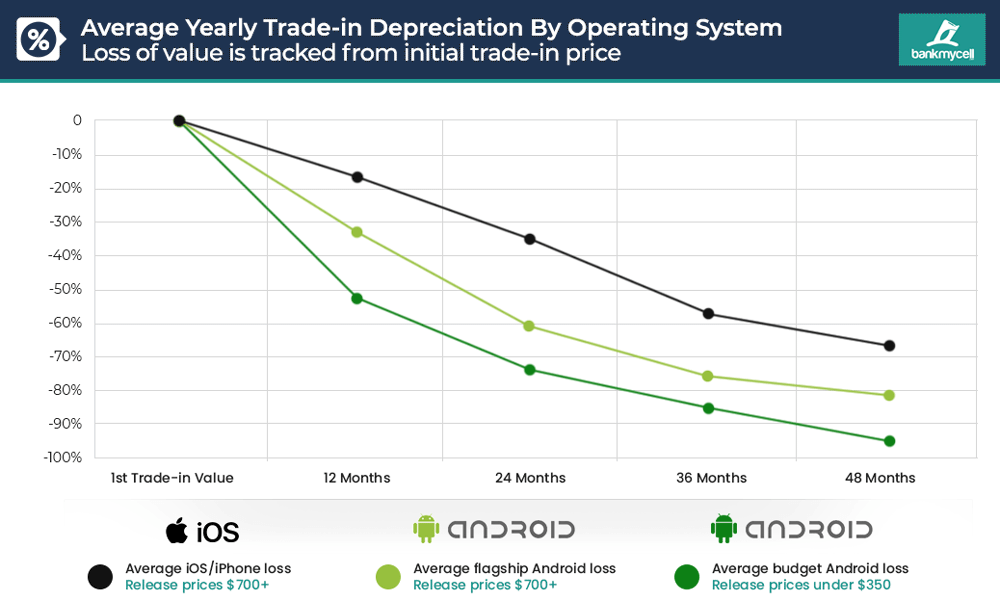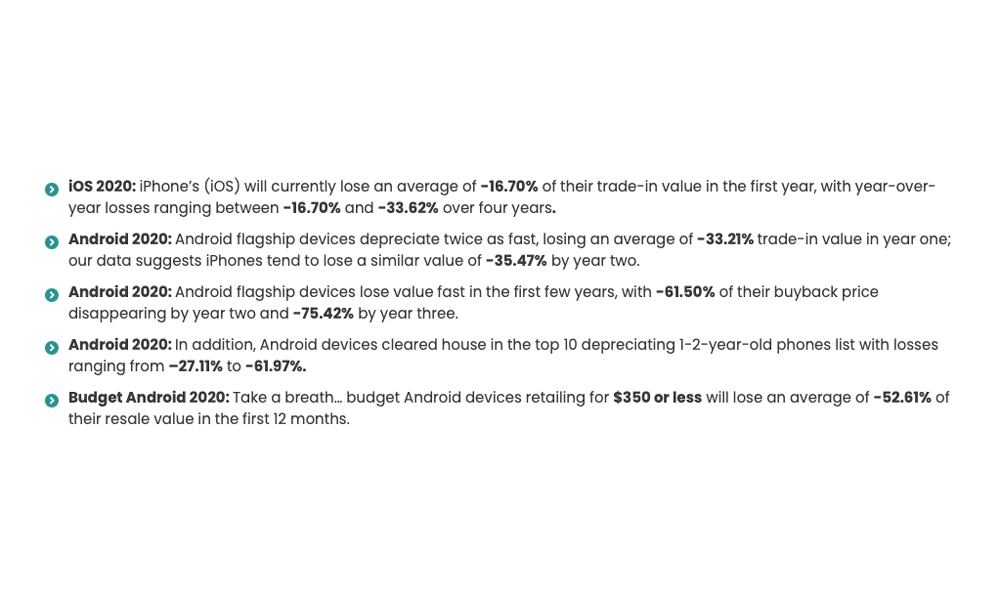The iPhone Continues to Dominate Its Android Rivals in This Key Area
 Credit: H_Ko / Shutterstock
Credit: H_Ko / ShutterstockToggle Dark Mode
There are lots of great reasons to buy an iPhone — the ultra-fast 5G performance, the gorgeous Super Retina OLED Display, the amazing camera system, and more — but here’s another one: When it comes time to upgrade to a new iPhone you’ll get much better value from trading or selling in your old one than with just about any other smartphone on the market.
While this shouldn’t come as any big surprise to Apple fans, since just about every Apple product is similarly great at retaining its value, a new report from BankMyCell offers some actual numbers on how significant this difference is between the iPhone and comparable flagship Android devices.
In fact, according to the numbers, high-end Android devices like the Samsung Galaxy S20 Ultra lose their value twice as fast as the equivalent iPhone models.
For example, the Samsung Galaxy S20 Ultra had a buyback price that was 64.71% less than its original value after only nine months. Meanwhile, an iPhone 11 Pro Max had depreciated by only 32.22%.
In fact, it takes up to about four years before the gap begins to narrow, although the iPhone still retains the edge at 66.43% versus Android’s 81.11% loss.
To put these numbers in perspective, this means that if you spent $999 on Samsung’s flagship when it was first released, you’d only be able to trade it in for around $350 nine months later. By comparison, a $1,099 iPhone 11 Pro Max purchased at launch would still fetch $745.
According to BankMyCell’s report, this gap remains fairly consistent across the entire initial two-year period, which the iPhone’s value falling by 16.7% and 35.47% in the first two years, respectively, compared to the average depreciation of Android devices landing at 33.62% and 61.5%.
Undoubtedly, a big part of this comes from the popularity of the iPhone in general, but it’s also worth keeping in mind that Apple continues to support the iPhone with iOS software updates years after most Android devices have been left in the dust; buy a two-year-old Samsung, and you’ll probably never see another Android update for it, while Apple’s latest iOS 14 release still runs just fine on the 2015 iPhone 6s, and an iPhone XS purchased today will likely continue to be supported through iOS 17.
A Clear Winner: The iPhone 11
While the numbers above refer to average value across all iPhone and Android devices, the clear standout appears to the standard iPhone 11, which accounts for 12.35% of all trade-ins that BankMyCell handled last year — more than any other single smartphone model.
By the end of 2020, the iPhone 11 had lost only 12.84% of its trade-in value, while Samsung’s equivalent, the Galaxy S20, dropped by a staggering 34.73% in only nine months.
Meanwhile, the iPhone 11 Pro and Galaxy S20+ came in a bit closer, at 21.315 and 30.59%, respectively, while the iPhone 11 Pro Max and Galaxy S20 Ultra were at 15.96% and 36.30%.
Budget Smartphones Fare Worse
While it’s only fair to compare the iPhone with flagship smartphones, it seems that the more wallet-friendly Android smartphones actually do much worse than their more expensive counterparts.
For example, a budget Android device that retailed for less than $350 loses half of its value in the first year, and is basically worthless by year four.
For example, the Samsung A50 lost 79.94% of its trade-in value by December 2020 from when it was first released in March 2019, and lest it look like we’re picking on Samsung here, Motorola’s G7 dropped by 79.17% in only nine months after its release.
In this category, the 2020 iPhone SE also fared much worse than the more expensive iPhone models, although it still does better than its budget Android counterparts. Calling it “Apple’s Black Swan,” BankMyCell notes that the iPhone SE has lost an average of 38.32% of its resale price only eight months after it was first released last spring, and this was true across the entire range, although the 64GB model fared only very slightly better than the higher-capacity versions.
The Worst Smartphones for Value
If the iPhone is the clear winner among the smartphones for having the best trade-in values by far, then you may be wondering which phones actually fare the worst.
Not surprisingly, even though the iPhone is a way better investment than any Android phone, it turns out that Samsung still does reasonably well among its Android brethren. On the other hand, phones by HTC, Motorola, and Sony all take nosedives in value after the first year, with some depreciating by as much as 81.82% after only 12 months.
As a whole, HTC was the worst, with an average drop of 53.08%, while Motorola and Sony came in at 42.57% and 39.51% respectively.








